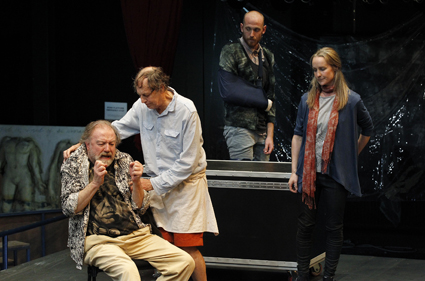 |
Bille Brown, Barry Otto, Josh Price, Edwina Wren, The Histrionic photo Jeff Busby |
the histrionic
Hysteric and histrionic sit nicely together phonologically although they have discrete etymological roots (respectively, “of the uterus” and “pertaining to acting”). Hysteria entails behaviour exhibiting excessive or uncontrollable emotion. An histrionic personality disorder is one in which the subject insists on being the centre of attention, behaves as if before an audience, is emotionally volatile and excessively sensitive to criticism. The description fits the ageing Bruscon, the actor who dominates Thomas Bernhardt’s The Histrionic. A “national living treasure” who has fallen on hard times, Bruscon and his family of performers find themselves in an Austrian backwater. So tryannical is Bruscon that he thwarts his children’s performances and has driven his wife into silence. Director Daniel Schlusser admirably realises the near chaotic state that such a personality generates. Director and designer surround the performers with a mess of decaying theatre props while the action comprises endless interruptions, emotional outbursts, fractured rehearsals and, finally, the destruction of Bruscon’s grand creation by a competing local sausage sizzle and a storm.
Fate and a backward culture deal Bruscon a cruel blow, but he is his own worst enemy. Dangerously fragile, he feels his status to be constantly threatened. The solution? Perpetual self-aggrandisement, rampant sexism, the belittling of his sons and a desire to control his daughter to the point of incest—with just a hint of reciprocity from her, despite the bitterness of their exchanges. In one of the many delicious visual asides, the daughter sits sharpening a very long knife while her father rehearses. For Bernhard, The Histrionic was a depiction of Austria, culturally decrepit and authoritarian and embodied in Bruscon who, nonetheless, is allowed a few insights into his country’s failures, if never his own. Bille Brown creates a very believable and frightening Bruscon, the primal ruler of the herd, in a performance that braves the not always manageable tendency of the play to the monodramatic and the monochromatic.
death of a salesman
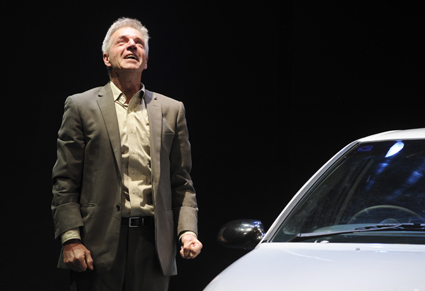 |
Colin Friels, Death of a Salesman photo Heidrun Löhr |
At the centre of an otherwise bare stage in Simon Stone’s production sits a humble, white 1996 Ford Falcon sedan, Willy’s proud possession. We know this is a cipher for the American cars so lovingly spoken of in the script, but a car is a car and Stone makes great use of it—it represents Willy’s travels, it’s a refuge and it’s a site for theatre magic as characters unexpectedly emerge from within its comforting womb. It’s also unpronouncedly and humbly phallic, a natural extension of the man, patted and fondled and admired. And when Willy no longer feels up to travel it becomes a place to die, not on the road, but in the yard. By centring the performance in and around the car, Stone creates a wonderful psychological seamlessness which, along with overlapping scene shifts, makes Willy’s visions of the past more palpable as they come over him like incipient dementia.
Like Bruscon, if without that man’s inherent sadism but blindly cruel nonetheless, Willy is beset by rage, despair and incomprehension and a desire for total control that is quite at odds with his place in the world. Willy is an arrogant performer, a fabulist, an histrionic and an hysteric whose failed dreams of being the ideal, loved worker and father take him to the edge of coherence and self-control. Bruscon is exemplar, critic and victim of the political failure of the state. Willy Loman is a passionate promulgator of the American Dream, enacting the state fantasy, imposing it on his family and destroying himself—victim and executor. Colin Friel’s performance is superb, supported by a very strong cast including Genevieve Lemon as Willy’s wife, Linda and there’s an excellent Biff from Patrick Brammall. Presumably because Stone, with designer Ralph Myers, has cast his Death of a Salesman as one man’s nightmare in which past and present deliriously mingle, there is no room for the final Requiem scene with Linda’s anguished eulogy—because it’s not part of Willy’s consciousness. Failing to find a way to incorporate the Requiem without sacrificing his vision, Stone takes the knife to Miller. Male hysteria?
old man
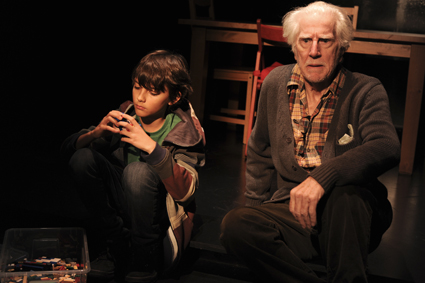 |
Zac Ynfante, Peter Carroll, Old Man photo Heidrun Löhr |
Perhaps then it seems a little too easy that in the real world Sam announces to his family that he has found his father and will go to see him. The scene with the father (Peter Carroll) is the play’s best. Carroll invests a simple man with complex, often unspoken responses. It’s clear to Sam there can be no meaningful reunion and perhaps that’s all he needs to know. However, at the play’s end, at the dinner table, Sam asks his family to never leave him. Ford plays it plainly but with just a touch of pleading that takes them by surprise, and an awkward silence ensues. Perhaps the good is that he has revealed himself to his family, the bad that his anxieties are still very real. Whittet doesn’t dig deep or at length in this short play, but the evocation of the emotional crisis of a very ordinary man in an intimately staged production is palpable.
die tote stadt
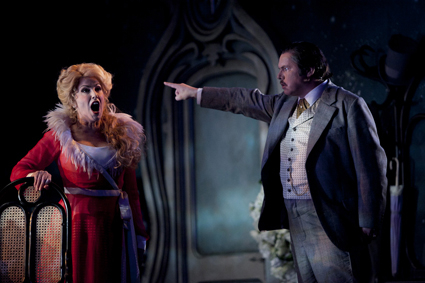 |
Cheryl Barker, Stefan Vinke, Die Tote Stadt, Opera Australia photo Lisa Tomasetti |
bell shakespeare, the duchess of malfi
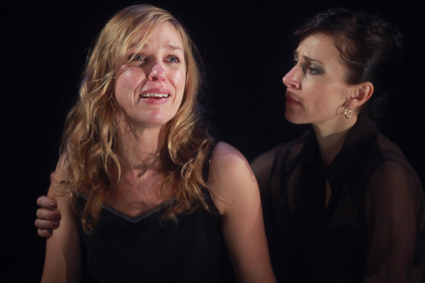 |
Lucy Bell, Lucia Mastrantone, The Duchess of Malfi photo Rush |
As with Simon Stone’s Death of a Salesman, if you give the play a governing consciousness, something has to give. Here, Bosola is left alive at the end, a wiser man, but without facing the full consequences of the biddings of his conscience—death. He is pretty well reduced to a Morality Play figure, but he should be much more than the bearer of rhymed homilies. Likewise we need more time and space in which to live with the Cardinal and the Judge and their festering hysteria.
Sydney Theatre Company, The Histrionic, Thomas Bernhard, translated by Tom Wright, director Daniel Schlusser, performers Bille Brown, Kelly Butler, Barry Otto, Josh Price, Katherine Tonkin, Jennifer Vuletic, Edwina Wren, design Marg Horwell, lighting Paul Jackson, sound design, composition Darrin Verhagen, Sydney Theatre Company, June 20-July 28; Belvoir, Death of a Salesman, writer Arthur Miller, director Simon Stone, performers Colin Friels, Genevieve Lemon, Patrick Brammall, Steve Le Marquand, Hamish Michael, Pip Miller, Luke Mullins, Blazey Best, design Ralph Myers, lighting Nick Schlieper, composer Stefan Gregory, Belvoir Theatre, opened June 23; Belvoir, Old Man, writer Matthew Whittet, director Anthea Williams, performers Alison Bell, Peter Carroll, Leon Ford, Gillian Jones, Madelaine Benson/Mitzi Ruhlmann, Tom Usher/Zac Ynfante, design Mel Page, lighting Hartley TA Kemp, sound Stefan Gregory, Belvoir Downstairs, June 7-July 22; Opera Australia, Die tote stadt, composer Erich Wolfgang Korngold, director Bruce Beresford, performers Stefan Vinke, Cheryl Barker, designer John Stoddart, lighting Nigel Levings, conductor Christian Badea, Sydney Opera House, July 3-18; The Duchess of Malfi, writer John Webster, adaptation Hugh Colman, Ailsa Piper, director John Bell, performers Lucy Bell, Ben Woods, Sean O'Shea, David Whitney, Matthew Moore, Lucia Mastrantone, designer Stephen Curtis, lighting Hartley TA Kemp, composer Alan John, sound design Steve Francis; Playhouse, Sydney Opera House, July 8-Aug 5
RealTime issue #110 Aug-Sept 2012 pg. 40
© Keith Gallasch; for permission to reproduce apply to [email protected]








 back
back